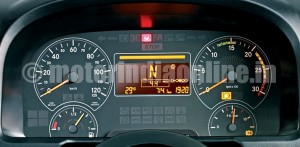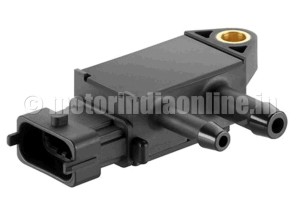Dr. Michael Jörg Ruf, CV & Aftermarket Business Head, Continental.
Continental has been at the forefront of technology advancement in the Indian automotive industry. The German firm is a global leader when it comes to pioneering technology and innovation towards enhancing performance, safety, comfort and connectivity in vehicles. As the Indian commercial vehicle industry looks to turn the corner, towards a growth phase, Dr. Michael Jörg Ruf, Executive Vice President – Business Unit Commercial Vehicles & Aftermarket, Continental Automotive GmbH, shares his thoughts on the future of the CV segment in India, upcoming technology trends and how Continental would play a major role in both.

Excerpts:
What are your major plans for the Indian market for the current year? The automotive industry seems to be back on the growth path after the long slowdown. How do you expect the year to be?
Speaking for the commercial vehicle market, we do expect a positive trend to emerge over the coming quarters, but the pace will not be constant in the foreseeable future. We feel that Continental in India is well positioned to benefit from this development. When it comes to the commercial vehicle segment, Continental has already localized the entire value chain, starting from local marketing to R&D to design according to local customers’ requirements in India. The focus is to localize and customize products at an optimized cost. Safety, fuel efficiency and information solutions continue to be our major drivers.
Continental is aiming to do a lot more in the commercial vehicle space in India. As far as instrumentation is concerned we’ve been awarded a number of new projects. However, there is much more scope for trucks to modernize in India and to use more electronic clusters with CAN connectivity, etc. With the current phase roll out, Euro-4 will become mandatory across the country in 2017. Commercial vehicle OEs would move to electronic EMS in their trucks and opt for electronic instrumentation. We are already getting signals from the OEMs to use more electronic clusters to upgrade their trucks.
From a segmental perspective, where does the commercial vehicle sector fall in your plans? What would your key focus areas be for the segment?
The commercial vehicle industry in India is going through a major evolution, with technological advancement being one of the key drivers of growth. The availability of better information management solutions will further drive this transformation. India is a strategic emerging market for our Commercial Vehicle Business Unit and Engine Systems Business Unit. Our key focus in India is the vehicle electronic segment (VE). We have established strategic relationships with our key customers, so that when demand grows we will be the preferred supplier for our customers in the area of electronic clusters. Furthermore, product development, design and manufacturing (software & hardware) are all led out of India for commercial vehicle projects.
Though developed markets like Europe seem to be getting saturated in terms of sales volumes when compared to the growth potential of developing markets like the BRIC nations, we continue to see unprecedented progress in the former when it comes to technology. How is technology adoption and acceptance in India? What should the country do to reach levels of other developed markets in this regard?
Consumers are becoming cost conscious, especially in the developing countries where millions are making their first purchase. An increasing number of buyers and manufacturers will become more aware of safety and environmental issues and will be supported by the Government. The uptake of electronics is always driven by needs like safety, comfort and connectivity and networking. As the volumes increase in emerging markets, customers will become more demanding and OEs will respond by engineering for the local customer.
With over 80 years of experience in the commercial vehicle segment in various global markets, along with our deep understanding of the requirements of Indian customers, Continental with its localized value chain in India, is well prepared for this development. With our philosophy of making commercial vehicles safer, cleaner and more fuel-efficient, our engineers in India will develop and build electronic systems and solutions plugging into the needs of our customers.
What are the technology trends you foresee in the Indian market in the next couple of years? What impact will they have on the market?
From passenger cars to commercial vehicles, the TFT technology is seeing a logical progression. Continental has recently introduced 5-inch TFTs for commercial vehicles in India and expects rapid adoption by OEs and fleet owners in the coming years.
Another trend in commercial vehicle instrumentation is the inclusion of a secondary screen for displaying optional content like images from the ProViu camera system. While the global CV industry has witnessed these trends in the recent past, such technologies are making inroads into India at a faster pace than before.
Safety is a major concern in the commercial vehicle segment. For example, the emergency brake assistant system, Accelerator Force Feedback Pedal, ARS300 radar sensor, object recognition and signal processing software and Continental eHorizon (which constantly sends small data packages via the vehicle’s data network – CAN bus) can make commercial vehicles safer on Indian roads. These packages contain information about the stretch of road ahead as well as topographic information. With this information, the engine control unit, the transmission control device or the driver assistance systems can optimize their respective functions. With eHorizon commercial vehicles can expect a reduction in fuel consumption, greater traffic safety and enhanced ride comfort.
We also develop networking/connectivity technologies which would eventually make fleet management more efficient – digital tachograph, customized telematics modules, tire guard, tire information system, intelligent antenna modules and our AutoLinQ platform. AutoLinQ is a flexible automotive-grade hardware and software platform. The scalable architecture is based on various views and provides vehicle owners with information that is relevant to their location. For example, through AutoLinQ’s mobile view fleet owners can ask questions or send commands from their mobile phone to their vehicle, including options like checking the status or location of a vehicle.
With global OEMs stressing the concept of total operating cost over the more commonly followed initial cost path in the Indian market, are we finally seeing Indian customers embrace the more sustainable life cycle cost concept? Please share your views on this.
The Indian truck transport market has relatively low operations cost (mainly drivers salaries and fuel cost) when compared with many other markets. Therefore the initial cost of the vehicle contributes significantly to the overall investment. Due to the high interest rates, this initial investment also contributes to the operating costs.
However, fleet managers here are increasingly evaluating the fuel cost and the net transport time needed for a shipment. Electronic Control Units play an important role in making engines more fuel effective and powerful, leading to significant savings in fuel and shorter delivery times. With this electronification of the vehicle, driver support functions like gear shift advisory through the instrumentation are being introduced in the Indian market and are further contributing to fuel efficiency.
Additionally, malfunction can be detected early and the relevant information is given to the driver through messages on the instrument display. In extreme cases, the engine switches into a protect mode allowing only limited engine speed to avoid severe damage.
In India, we are also seeing a growing interest in best cost telematics solutions, allowing fleet owners to plan better and generate a higher income per vehicle.

